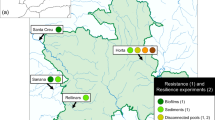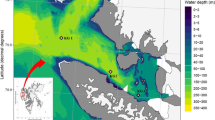Abstract
Denitrification is a major mechanism for nitrogen removal from nitrogen-rich waters, but it requires oxygen-poor conditions. We assessed denitrification rates in nitrate-rich but also oxygen-rich river water during its stay in a floodplain. We measured diurnal oxygen fluctuations in floodwater along the river Rhine, and carried out an experiment to assess denitrification rates during day, evening and night. Denitrification in floodwater and flooded sediment were measured, comparing activity of periphyton and sediment from agricultural grasslands and reedbeds. Floodwater along the river Rhine was oxygen-saturated (> 10 mg O2/L) during the day, but oxygen largely disappeared during the night (0.4–0.8 mg O2/L). Independent of oxygen concentrations, denitrification in surface water alone hardly occurred. In flooded sediments, however, denitrification rates were much higher (1.1–1.5 mg N m−2 h−1), particularly at dark and oxygen-poor conditions (nighttime). In the experimental jars, reedbed-periphyton bacteria achieved similar denitrification rates as bacteria in sediment, but overall periphyton denitrification was of minor importance when calculated per square meter. Apart from oxygen levels, maximum denitrification appeared to be regulated by nitrate diffusion from water into the sediment, as the maximum quantity of N denitrified in the sediment equalled the quantity of N lossed from the surface water. Assessed 24-hr denitrification rates in the flooded floodplains (c. 15 mg N m−2 d−1) were similar in grasslands and reedbeds, and were rather low compared to rates in other floodplains.
Similar content being viewed by others
References
Alexander R.B., Smith R.A. and Schwartz G.E. 2000. Effect of stream channel size on the delivery of nitrogen to the Gulf of Mexico. Nature 403: 758–761.
Bowden W.B. 1987. The biogeochemistry of nitrogen in freshwater wetlands. Biochem. 4: 313–348.
Caraco N.F. and Cole J.J. 1994. Human impact on nitrate export: an analysis using major world rivers. Ambio 28: 167–170.
Christensen P.B., Nielsen L.P., Sørensen J. and Revsbech N.P. 1990. Denitrification in nitrate-rich streams: diurnal and seasonal variation related to benthic oxygen metabolism. Limnol. Oceanogr. 35: 640–651.
Cronk J.K. and Mitsch W.J. 1994. Aquatic metabolism in four newly constructed freshwater wetlands with different hydrologic inputs. Ecol. Engineer. 3: 449–468.
Dalsgaard T. and Revsbech N.P. 1992. Regulating factors in trickling filter biofilms as measured with the oxygen/nitrous oxide microsensor. FEMS Microbiol. Ecol. 101: 151–164.
Eriksson P.G. and Weisner S.E.B. 1996. Functional differences in epiphytic microbial communities in nutrient-rich freshwater ecosystems: an assay of denitrifying capacity. Freshwater Biol. 36: 555–562.
Eriksson P.G. and Weisner S.E.B. 1997. Nitrogen removal in a wastewater reservoir: the importance of denitrification by epiphytic biofilms on submerged vegetation. J. Environ. Qual. 26: 905–910.
Eriksson P.G. and Weisner S.E.B. 1999. An experimental study on effects of submerged macrophytes on nitrification and denitrification in ammonium-rich aquatic systems. Limnol. Oceanogr. 44: 1993–1999.
Eriksson P.G. 2000. Regulation of Epiphytic Nitrification and Denitrification in Macrophyte-Dominated Systems. PhD Thesis, Lund University, Lund.
Fennessy M.S. and Cronk J.K. 1997. The effectiveness and restoration potential of riparian ecotones for the management of nonpoint source pollution, particularly nitrate. Crit. Rev. Environ. Sci. Tech. 27: 285–317.
Groffman P.M., Axelrod E.A., Lemunyon J.L. and Sullivan W.M. 1991. Denitrification in grass and forest vegetated filter strips. J. Environ. Qual. 20: 671–674.
Haycock N.E., Pinay G. and Walker 1993. Nitrogen retention in river corridors; European perspectives. Ambio 22: 340–346.
Hill A. 1979. Denitrification in the nitrogen budget of a river ecosystem. Nature 281: 291–292.
Howard-Williams C. 1985. Cycling and retention of nitrogen and phosphorus in wetlands: a theoretical and applied perspective. Freshwater Biol. 15: 391–431.
Howarth R.W., Billen G., Swaney D., Townsend A., Jaworski N., lajtha K. et al. 1996. Regional nitrogen budgets and riverine N and P fluxes for the drainages to the North Atlantic Ocean: natural and human influences. Biogeochem. 35: 75–139.
Johnston C.A. 1991. Sediment and nutrient retention by freshwater wetlands: effects on surface water quality. Crit. Rev. Environ. Contr. 21: 491–565.
Keddy P.A. 2000. Wetland ecology, principles and conservation. Cambridge University Press, Cambridge.
Kersting K. and Kouwenhoven P. 1989. Annual and diel oxygen regime in two polder ditches. Hydrobiol. Bull. 23: 111–123.
McMahon P.B., Tindall J.A., Collins J.A., Lull K.J. and Nuttle J.R. 1995. Hydrologic and geochemical effects on oxygen uptake in bottom sediments of an effluent-dominated river. Water Resour. Res. 31: 2561–2569.
Mitsch W.J., Day J.W., Gilliam J.W., Groffman P.M., Hey D.L., Randall G.W. et al. 2001. Reducing nitrogen loading to the Gulf of Mexico from the Mississippi River basin: strategies to counter a persistent ecological problem. Bioscience 51: 373–388.
Naiman R.J. and Décamps H. 1997. The ecology of interfaces: riparian zones. Ann. Rev. Ecol. Syst. 28: 621–658.
Nielsen L.P., Christensen P.B., Revsbech N.P. and Sørensen J. 1990. Denitrification and oxygen respiration in biofilms studied with a microsensor for nitrous oxide and oxygen. Microb. Ecol. 19: 63–72.
Olde Venterink H., Davidsson T., Kiehl K. and Leonardson 2002. Impact of drying and re-wetting on N, P and K dynamics in a wetland soil. Plant Soil 243: 119–130.
Olde Venterink H., Wiegman F., Van der Lee G.E.M. and Vermaat J.E. 2003. The role of active floodplains for nutrient retention in the river Rhine. J. Environ. Qual. (in press).
Osborne L.L. and Kovacic D.A. 1993. Riparian vegetated buffer strips in water-quality restoration and stream management. Fresh. Biol. 29: 243–258.
Patrick W.H. and Reddy K.R. 1976. Denitrification reactions in flooded soils and water bottoms: dependence on oxygen supply and ammonium diffusion. J. Environ. Qual. 4: 469–471.
Pinay G., Haycock N.E., Ruffinoni C. and Holmes R.M. 1994. The role of denitrification in nitrogen removal in river corridors. In: Mitsch W.J. (ed.), Global Wetlands: Old World and New. Elsevier, Dordrecht, pp. 107–117.
Pinay G., Roques L. and Fabre A. 1993. Spatial patterns of denitrification in a riparian forest. J. Appl. Ecol. 30: 581–591.
Pinay G., Ruffinoni C. and Fabre A. 1995. Nitrogen cycling in two riparian forest soils under different geomorhic conditions. Biogeochem. 30: 9–29.
Schreijer M., Kampf R., Verhoeven J.T.A. and Toet S. 2000. Nabehandeling van RWZI-effluent tot bruikbaar oppervlaktewater in een moerassysteem. Report Hoogheemraadschap van Uitwaterende Sluizen in Hollands. Noorderkwartier Utrecht University.
Seitzinger S.P. 1988. Denitrification in freshwater and coastal marine ecosystems: ecological and geochemical significance. Limnol. Oceanogr. 33: 702–724.
Seitzinger S.P. 1994. Linkages between organic matter mineralization and denitrification in eight riparian wetlands. Biogeochem. 25: 19–39.
Seitzinger S.P., Styles R.V., Boyer E.W., Alexander R.B., Billen G., Howarth R.W. et al. 2002. Nitrogen retention in rivers: Model development and application to wattersheds in the northeastern U.S.A. Biochem. 57/58: 199–237.
Sjodin A.L., Lewis W.M. Jr and Saunders J.F. III 1997. Denitrification as a component of the nitrogen budget for a large plains river. Biogeochem. 39: 327–342.
Spink A., Sparks R.E., Van Oorschot M. and Verhoeven J.T.A. 1998. Nutrient dynamics of large river floodplains. Regulated Rivers 14: 203–216.
Tiedje J.M. 1988. Ecology of denitrification and dissimilatory nitrate reduction to ammonium. In: Zehnder A.J.B. (ed.), Biology of Anaerobic Microorganisms. John Wiley and Sons, New York.
Van der Lee G.E.M., Olde Venterink H. and Asselman N.E.M. 2003. Estimation of nutrient retention in floodplains of the Rhine distributaries in The Netherlands: upscaling the effect on river water quality. River Res. Appl. (in press).
Verhoeven J.T.A., Whigham D.F., Van Logtestijn R. and O'Neill J. 2001. A comparative study of nitrogen and phosphorus cycling in tidal and non-tidal riverine wetlands. Wetlands 21: 210–222.
Vought L.B.M., Dahl J., Lauge Pedersen C. and Lacousière J.O. 1994. Nutrient retention in riparian ecotones. Ambio 23: 342–348.
Vymazal J. 2001. Types of constructed wetlands for wastewater treatment; their potential for nutrient removal. In: Vymazal J. (ed.), Transformations of Nutrients in Natural and Constructed Wetlands. Backhuys Publishers, Leiden, pp. 1–93.
Weisner S.E.B., Eriksson P.G., Granéli W. and Leonardson L. 1994. Influence of macrophytes on nitrate removal in wetlands. Ambio 23: 363–366.
Yoshinari T. and Knowles R. 1976. Acetylene inhibition of nitrous oxide reduction by denitrifying bacteria. Biochem. Bioph. Res. Co. 69: 705–710.
Rights and permissions
About this article
Cite this article
Venterink, H.O., Hummelink, E. & Van Den Hoorn, M. Denitrification potential of a river floodplain during flooding with nitrate-rich water: grasslands versus reedbeds. Biogeochemistry 65, 233–244 (2003). https://doi.org/10.1023/A:1026098007360
Issue Date:
DOI: https://doi.org/10.1023/A:1026098007360




